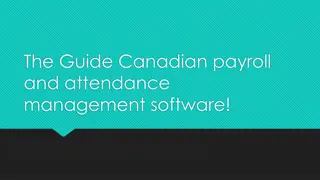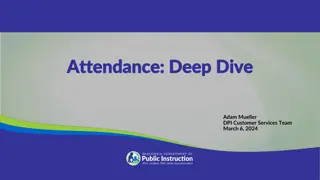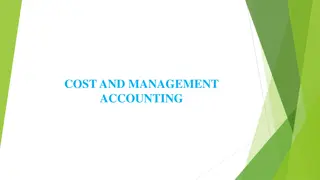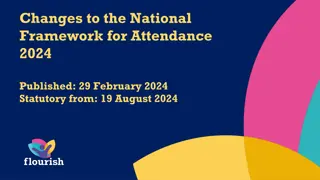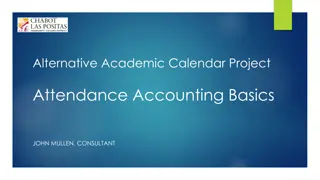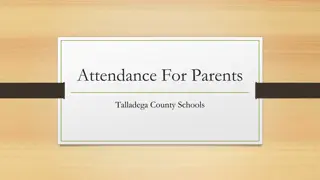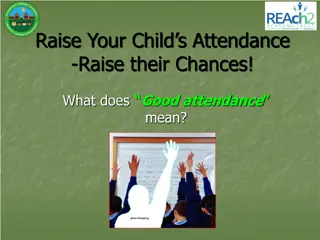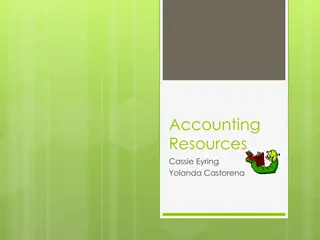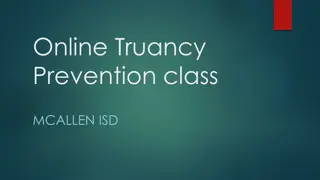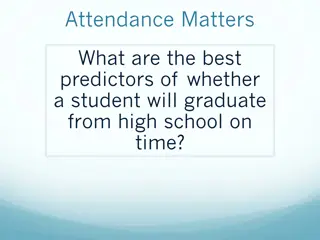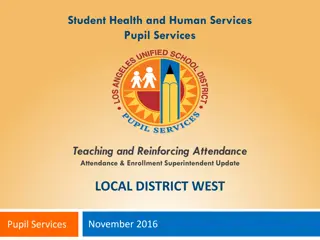Student Attendance Accounting Handbook 2022-23 Program Highlights
The Student Attendance Accounting Handbook (SAAH) provides essential guidelines for Texas school districts to maintain accurate attendance records for funding purposes. The handbook outlines the legal requirements, responsibilities, and procedures for recording student attendance data. It covers various sections such as prekindergarten, audit requirements, special education, career and technology programs, and more. The document emphasizes the importance of adhering to state laws regarding student attendance to ensure proper allocation of education funds. Key reminders include allowing excused absences and not withdrawing temporarily absent students. For detailed information, districts can refer to the SAAH for comprehensive guidance.
Download Presentation

Please find below an Image/Link to download the presentation.
The content on the website is provided AS IS for your information and personal use only. It may not be sold, licensed, or shared on other websites without obtaining consent from the author. Download presentation by click this link. If you encounter any issues during the download, it is possible that the publisher has removed the file from their server.
E N D
Presentation Transcript
Student Attendance Accounting Handbook 22-23 Program Proposed Highlights
SAAH Staff Joe Herrera (512) 463-7708 joe.herrera@tea.texas.gov Padmaja Pija Sathyanarayan (512) 475-2012 padmaja.sathyanarayan@tea.texas.gov Attendance@tea.texas.gov Student Attendance Accounting Handbook | Texas Education Agency 2
SAAH Background, What & Why State law requires that every Texas school district adopts an attendance accounting system that includes procedures to ensure the accurate recording and reporting of student attendance data. The Student Attendance Accounting Handbook (SAAH) contains the official attendance accounting requirements that all public school districts and open- enrollment charter schools in Texas must meet. The agency collects student attendance data primarily to ensure that Foundation School Program (FSP) funds can be correctly allocated to Texas s public schools. 4
SAAH by Section 1-13 1: Overview 7: Prekindergarten 2: Audit Requirements general, system, documentation 3: Attendance responsibilities, attendance taking, calendars 4: Special Education ECSE 5: Career and Technology (CTE) contact hours, documentation 6: Emergent Bilinguals/English Learners 8: Gifted/Talented 9: Pregnancy Related Services 10: AEP and Disciplinary Removals 11: Nontraditional Programs dual credit, OFSDP 12: Virtual Remote and Electronic Learning 13: Appendix 5
SAAH Reminder 3.6.3 TEC, 25.087(d) Your school district must allow a student whose absence is excused for any of the previously listed reasons with the exception of the first five reasons, for which this paragraph does not apply a reasonable amount of time to make up school work missed on these days. If the student satisfactorily completes the school work, the day of absence is counted as a day of compulsory attendance.9 6
SAAH Reminder 1 3.4.2 Temporary Absences and Withdrawal Your district must not withdraw a student who is temporarily absent (for example, as a result of illness or suspension) but still a member of your district. 7
SAAH Reminder 2 3.4.3 Students Whose Whereabouts Are Unknown Your district should decide the withdrawal date for a student who never officially withdrew from school, but whose whereabouts can no longer be determined, according to applicable local policies. For example, local policy may state that a student is withdrawn 10 days after he or she last attended if his or her whereabouts are unknown. Once withdrawn, a student in grades seven through 12 must be reported as a school leaver on the 40203 School Leaver Extension and could be considered a dropout according to Section 2 Audit Requirements of the TSDS PEIMS Data Standards 8
SAAH 21-22 Changes 3.3.9 Infants and Toddlers with Auditory Who Are Deaf or Hard of Hearing or Have Visual Impairment of Both SAAH Section 4 Special Education 4.4 Withdrawal Special Education Dismissal Procedures 10
SAAH 21-22 Changes 1 3.7 General Education Homebound (GEH) Program Any student who is served through the GEH program must meet the following three criteria: The student is expected to be confined at home or hospital bedside for a minimum of four weeks. The weeks need not be consecutive. The student is confined at home or hospital bedside for medical reasons only. The student must have a medical condition that is documented by a physician licensed1 to practice in the United States. Except in cases of medically fragile students, potential medical conditions or concerns that students may develop medical conditions do not constitute grounds for GEH program eligibility. A student served through the GEH program at home or hospital bedside must be served by a certified general education teacher. Over the period of his or her confinement, the student must be provided instruction in all core academic subject area courses in which the student is enrolled. In addition, over the period of confinement, the student should be provided instruction in all other courses the student is enrolled in, if possible. In cases where students are medically able to receive more than the required minimum four hours of face to face instruction, LEAs must may provide additional remote instruction. Please note that concurrent instruction is not allowed. 11
SAAH 21-22 Changes 2 5.3 Enrollment Procedures The procedures for enrolling a student in CTE courses are as follows: 1. A student enrolls in school, and [the student s class schedule is determined.]school personnel review the student s Personal Graduation Plan (PGP) to identify the courses necessary to complete the program(s) of study. 2. Appropriate CTE staff members review [the student s schedule and determine the correct CTE code.]CTE courses, as necessary, to ensure the appropriate V-code (V1, V2, V3) is connected to the courses. 3. [Attendance personnel record the CTE code in the attendance accounting system.]Designated CTE staff review changes in the student s schedule. [4. Appropriate CTE staff members review changes in the student s schedule.] 12
SAAH 21-22 Changes 3 5.5 CTE (Contact Hours) Codes A student who is enrolled in CTE courses approved for state weighted funding must have a corresponding CTE code (V1, V2, or V3[, V4, V5, or V6]), based on the course service ID. For students who are enrolled in more than one CTE course, CTE codes are combined to determine the correct code assigned to each student. For example, a student enrolled in three separate 45-minute CTE courses would be assigned a code of V3 (V1 + V1 + V1 = V3).] 13
SAAH 21-22 Changes 4 5.12 CTE Examples 5.12.1 5.12.2 5.12.3 5.12.6 5.12.7 5.12.9 5.12.12 5.12.13 5.12.15 5.12.5 5.12.10 14
SAAH 21-22 Changes 5 6.2 Identification of Emergent Bilinguals (EBs)/English Learners (ELs) and Enrollment Procedures 4. The LPAC must give written notice to the student s parents informing them that the student has been classified as emergent bilingual and requesting documented parental approval to place the student in the required bilingual or ESL education program. The notice must include information about the benefits of the bilingual or ESL education program for which the student has been recommended and state that it is an integral part of the school program (19 TAC 89.1220(h)). The parental approval form must contain a space for the parent s or legal guardian s signature and a space for the date the form was signed [or documented approval must be obtained] for written approval, or parental approval may be obtained through a documented phone conversation or email that is documented in writing and retained in accordance with 19 TAC 89.1220 (m). 15
Program Proposed 22-23 SAAH Changes 1 District Local Education Agency (LEA) 17
Program Proposed 22-23 SAAH Changes 3 3.4.2 Temporary Absences and Withdrawal Your district must not withdraw a student who is temporarily absent (for example, as a result of illness, hospitalization, treatment for a mental health or substance abuse condition, or suspension) but still a member of your district. 19
Program Proposed 22-23 SAAH Changes 4 3.6.3 Requirements for a Student to be Considered Present for FSP (Funding) Purposes A student with a mental health or substance abuse condition who is being treated for a serious illness (TEC 25.087(b)(3)) in an outpatient day treatment program or partial hospitalization program, under the care of a health care professional licensed, certified, or registered to practice in Texas, shall be excused for the authorized treatment period, and shall not be withdrawn from school. 20
Program Proposed 22-23 SAAH Changes 6 3.6.3 Requirements for a Student to be Considered Present for FSP (Funding) Purposes The discharge summary from the outpatient day treatment or partial hospitalization program must include treatment admission, and discharge dates to be provided to the school by the family upon return to school as documentation to excuse absences for the duration of the authorized outpatient treatment plan or partial hospitalization. 21
Program Proposed 22-23 SAAH Changes 76 Section 4 Special Education 4.3.3.2 Summer Enrollment Procedures A student with a disability who has an IEP in place from a previous in- or out-of-state school district and who enrolls in a new school district during the summer is not considered a transfer student for the purposes of this subsection or for 34 CFR, 300.323(e) or (f). For these students, the new school district must implement the IEP from the previous school district in full on the first day of class of the new school year or must convene an ARD committee meeting during the summer to revise the student's IEP for implementation on the first day of class of the new school year. 22
Program Proposed 22-23 SAAH Changes 8 Section 5 Career and Technology (CTE) 23
Program Proposed 22-23 SAAH Changes 12 Section 5 Career and Technology (CTE) Watch for specific guidance from CTE regarding LEAs choosing to move to a 4-day week 25
Program Proposed 22-23 SAAH Changes 13 Section 6 Bilingual/English as a Second Language (ESL) Within this section, the term "parent" includes the parent or legal guardian of the student in accordance with TEC, 29.052. Also, term district includes all local education agencies, open-enrollment charter schools, and districts of innovation. 26
Program Proposed 22-23 SAAH Changes 14 6.2 Identification of Emergent Bilingual (EB) Students/English Learners (ELs) and Enrollment Procedures Parents may request a correction on the HLS only if the child has not yet been assessed for English proficiency and corrections are made within two calendar weeks of the child s enrollment date. 27
Program Proposed 22-23 SAAH Changes 15 6.2 Identification of Emergent Bilingual (EB) Students/English Learners (ELs) and Enrollment Procedures 28
Program Proposed 22-23 SAAH Changes 16 6.5 Program Services: Eligibility for State Bilingual Education Allotment (BEA) Funding 6.6 Program Services: Teacher Certification Requirements 6.9 Monitoring of a Student Who Has Been Reclassified 6.10.2 Other Required Documentation 29
Program Proposed 22-23 SAAH Changes 17 Section 11 Nontraditional Programs 11.6 Optional Flexible School Day Program (OFSDP) 11.6.1 Student Eligibility There must be an agreement in writing to the student s participation: by the student, if the student is over 18 years of age; or by the student and the student s parent or person standing in parental relation to the student, if the student is less than 18 years of age and not emancipated by marriage or court order. 30
Program Proposed 22-23 SAAH Changes 18 Section 9 Pregnancy-Related Services (PRS) 9.11 Returning to Campus for Support Services or Testing A student that has been confined to the home by a medical practitioner during their prenatal or postpartum period A student confined to the home may be allowed to return to campus and remain coded PRS to receive temporary, limited support services (see the introduction to Section 9 Pregnancy-Related Services (PRS) for a list of examples of support services) or take required state assessments. For a PRS student that was only receiving their normal six weeks of CEHI, since there is no medical practitioner s note required, there is no medical release requirement to return to campus for testing during this time. Only during the prenatal or extended postpartum period is a medical release required 31
Program Proposed 22-23 SAAH Changes 19 Glossary admission, review, and dismissal (ARD) committee A team established by membership requirements under 19 TAC 89.1050 at each school district or special education shared services arrangement that meets to determine eligibility based on a full and individual evaluation report, and to develop an individualized education program (IEP) for the child, if applicable. All members of the ARD committee must have the opportunity to participate in a collaborative manner in developing a student s IEP. A committee that each school district or special education shared services arrangement is required to establish and that makes decisions concerning the educational program of a student referred for special education. All members of the ARD committee must have the opportunity to participate in a collaborative manner in developing a student s IEP. 32
Program Proposed 22-23 SAAH Changes 21 Glossary bilingual/English as a second language (ESL) eligible days A term used to describe the days that bilingual or ESL students participating in a bilingual education or ESL program were in attendance. Your district should count only students who meet eligibility requirements and are served by staff members certified or on permit to teach bilingual education, ESL education, or both,This includes students participating in a standard bilingual education or ESL program per TAC 89.1210 (c) and (d) or students who are served participating in a temporary alternative language program (ALP) approved by TEA under an bilingual education exception or an ESL waiver (Section 6 Bilingual/English as a Second Language (ESL). 33
Program Proposed 22-23 SAAH Changes 22 Glossary early education (EE) A grade level for students through five years of age who have not been placed in prekindergarten or kindergarten. These students include students receiving special education services who do not meet the two hours of instruction per day requirement for membership and students in a Head Start program that does not meet the requirements for state fundsSee Section 3 General Attendance Requirements and Section 4 Special Education for EE coding requirements. These students also include those served by preschool program for children with disabilities teachers in a licensed child care facility working in a collaborative partnership with your school district. 34
Program Proposed 22-23 SAAH Changes 23 Glossary gifted/talented (G/T) student means a child or youth who performs at or shows the potential for performing at a remarkably high level of accomplishment when compared to others of the same age, experience, or environment and who exhibits high performance capability in an intellectual, creative, or artistic area; possesses an unusual capacity for leadership; or excels in a specific academic field. 35
Program Proposed 22-23 SAAH Changes 24 Glossary individualized education program (IEP) A program developed by an ARD committee for each student served in special education. The IEP should include the frequency, location, and duration of special education and related services and the amount of services the student is to receive as well as the to determine the instructional setting code. This information is necessary for proper coding of special education students in the attendance accounting system. 36
Questions? 37
Thank you! Joe Herrera, Manager of Student Attendance Accounting Handbook and SHARS Financial Compliance Division, Texas Education Agency
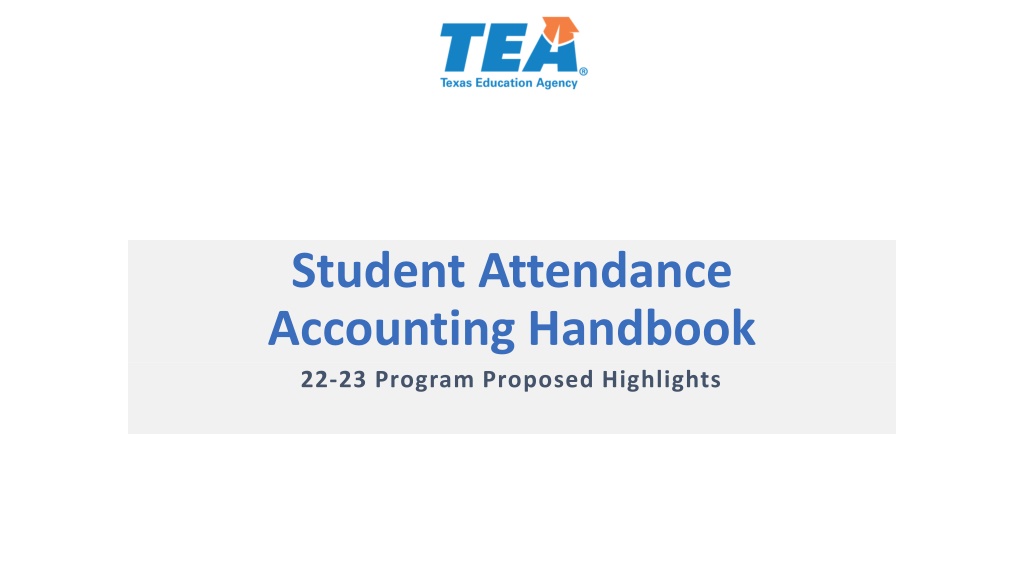
 undefined
undefined





